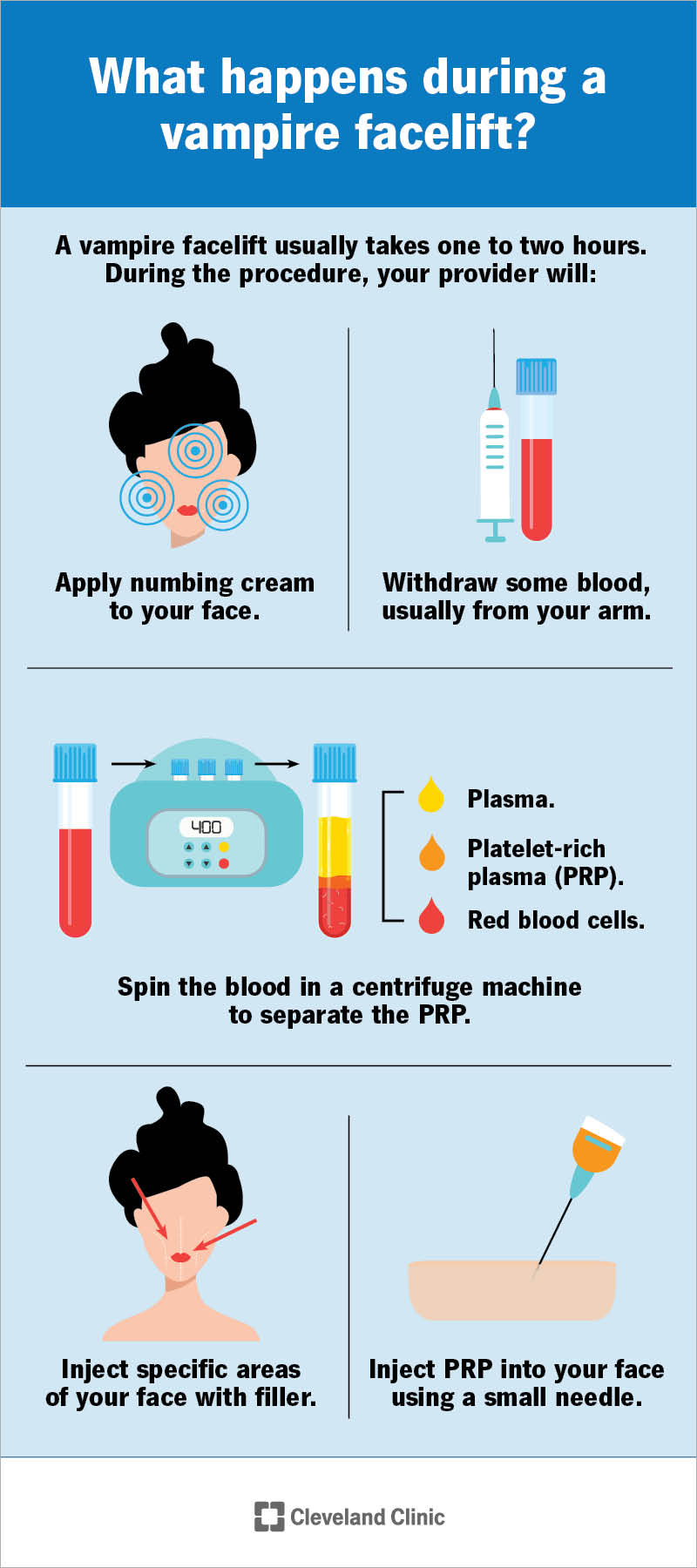A vampire facelift (PRP facelift) revitalizes your face without surgery. Providers inject platelet-rich plasma (PRP) with hyaluronic acid filler to contour your face, reduce wrinkles and plump skin. There are minimal side effects like bruising, swelling and tenderness. This procedure is an alternative to a surgical facelift.
Advertisement
Cleveland Clinic is a non-profit academic medical center. Advertising on our site helps support our mission. We do not endorse non-Cleveland Clinic products or services. Policy

A vampire facelift, or PRP facelift, is a procedure to rejuvenate your facial skin without surgery. This procedure uses injections of platelet-rich plasma (PRP) and a temporary dermal filler (hyaluronic acid filler). It’s known as a vampire facelift because the main ingredient in the filler is your blood. You’ll notice immediate results comparing your skin before and after a PRP facelift.
Advertisement
Cleveland Clinic is a non-profit academic medical center. Advertising on our site helps support our mission. We do not endorse non-Cleveland Clinic products or services. Policy
Platelet-rich plasma is part of your blood. Plasma is the liquid portion of your blood. Platelets are cells within your blood that contain growth factors and help your blood clot to prevent bleeding. PRP is blood that contains only growth factors, platelets and plasma.
A healthcare provider will collect PRP by drawing your blood and putting it through a centrifuge. This is a machine that spins your blood at high speeds. The centrifuge separates your blood into different components:
Once your blood finishes spinning in the centrifuge, your provider will remove the platelet-rich plasma component to be injected into your face.
A vampire facelift is an alternative treatment to a surgical facelift. Platelet-rich plasma claims to:
A PRP facelift may help:
A vampire facelift (PRP facelift) combines injections of platelet-rich plasma with hyaluronic acid filler. During a vampire facial, your provider spreads PRP over your face. Then, they use microneedling or tiny pricks that help your face absorb the plasma. Vampire facials target issues on the surface of your skin, including:
Advertisement
Before a vampire facelift (PRP facelift), you’ll have a consultation with a healthcare provider. They’ll ask about your health history to see if you’re a good candidate for the procedure. A PRP facelift isn’t recommended if you:
If you’re a good candidate for a PRP facelift, your provider will examine your skin and talk about what you want to achieve from the procedure. If you decide to go ahead with a PRP facelift, your provider may ask you to:
During a vampire facelift procedure, your healthcare provider will:
A PRP facelift usually takes one to two hours.
You won’t feel pain during a vampire facelift because your healthcare provider will numb your skin. You may feel light to mild pain once the numbing cream wears off.
After a PRP facelift, you may experience mild discomfort and bruising for a couple of days, up to a week. You should be able to go about your day with caution after the procedure.
You can apply ice packs wrapped in a towel to your face as needed to reduce swelling. You can take over-the-counter pain relievers as directed. When you go to bed, elevate your head and try to sleep on your back. Your provider will give you specific instructions to care for your skin after the procedure.
Benefits of a vampire facelift (PRP facelift) include:
Studies are limited when it comes to calculating the success of vampire facelifts. The benefits of PRP may promote improvement in your skin texture and it works as a treatment to reduce wrinkles.
If you choose to try a PRP facelift, be sure to consult with a board-certified plastic surgeon or dermatologist about the benefits and risks.
Advertisement
Side effects of a PRP facelift could include:
Rarely, you may experience a reaction to the hyaluronic acid filler, which could include:
A more serious risk is that a provider could inject filler into a blood vessel. This can cause tissue in the area to die.
Look for an experienced provider, like a board-certified plastic surgeon or dermatologist, to minimize complications from the procedure.
Recovery time after a vampire facelift (PRP facelift) tends to be short. Your surgeon will give you instructions to take care of your skin and decrease your recovery time. Some aftercare instructions may include avoiding:
If you experience swelling, you can try using an ice pack. Acetaminophen (Tylenol®) can also help reduce any pain.
You can usually return to your regular activities immediately. Your healthcare provider will offer guidance suitable for your recovery.
Advertisement
After a PRP facelift, you’ll notice plumping from the filler right away. You’ll begin to see smoothing from the PRP after about two weeks.
The final results from a vampire facelift can last from about 12 to 18 months. Some providers recommend three sets of injections, one per month for three months, to prolong the effects.
Talk to your healthcare provider if you have any of these symptoms after a vampire facelift (PRP facelift):
A vampire facelift (PRP facelift) may sound like a scary movie. But it’s really a nonsurgical way to rejuvenate your face. PRP facelifts use injections of platelet-rich plasma (PRP) along with a dermal filler rather than a traditional facelift surgery. There are usually minimal side effects and a short recovery time. Researchers have not yet done extensive studies on PRP treatments for facial rejuvenation. Talk to a board-certified plastic surgeon or dermatologist if you decide to try a PRP facelift.
Advertisement
Whether you need cosmetic or reconstructive plastic surgery, you’ll need skilled, detailed and compassionate providers. At Cleveland Clinic, we’re here to help.

Last reviewed on 03/13/2024.
Learn more about the Health Library and our editorial process.